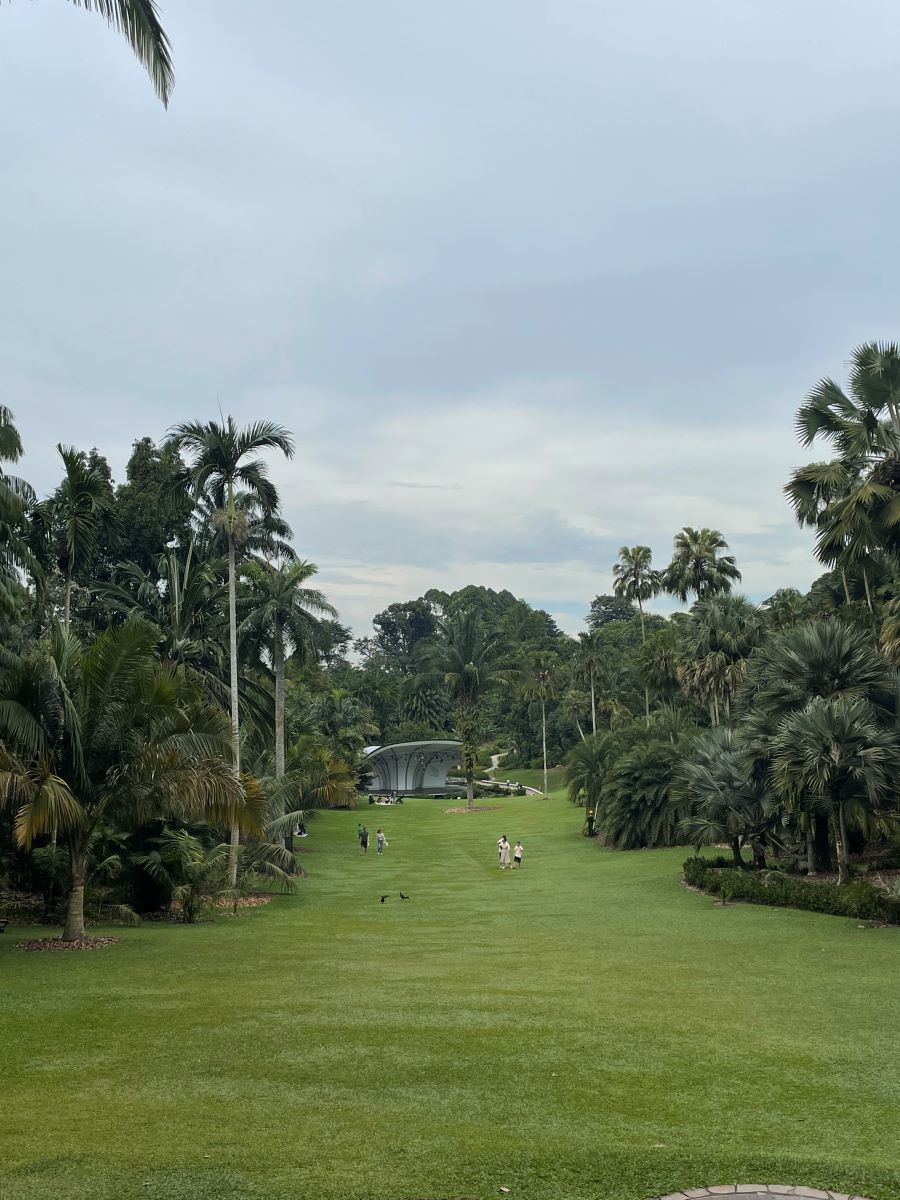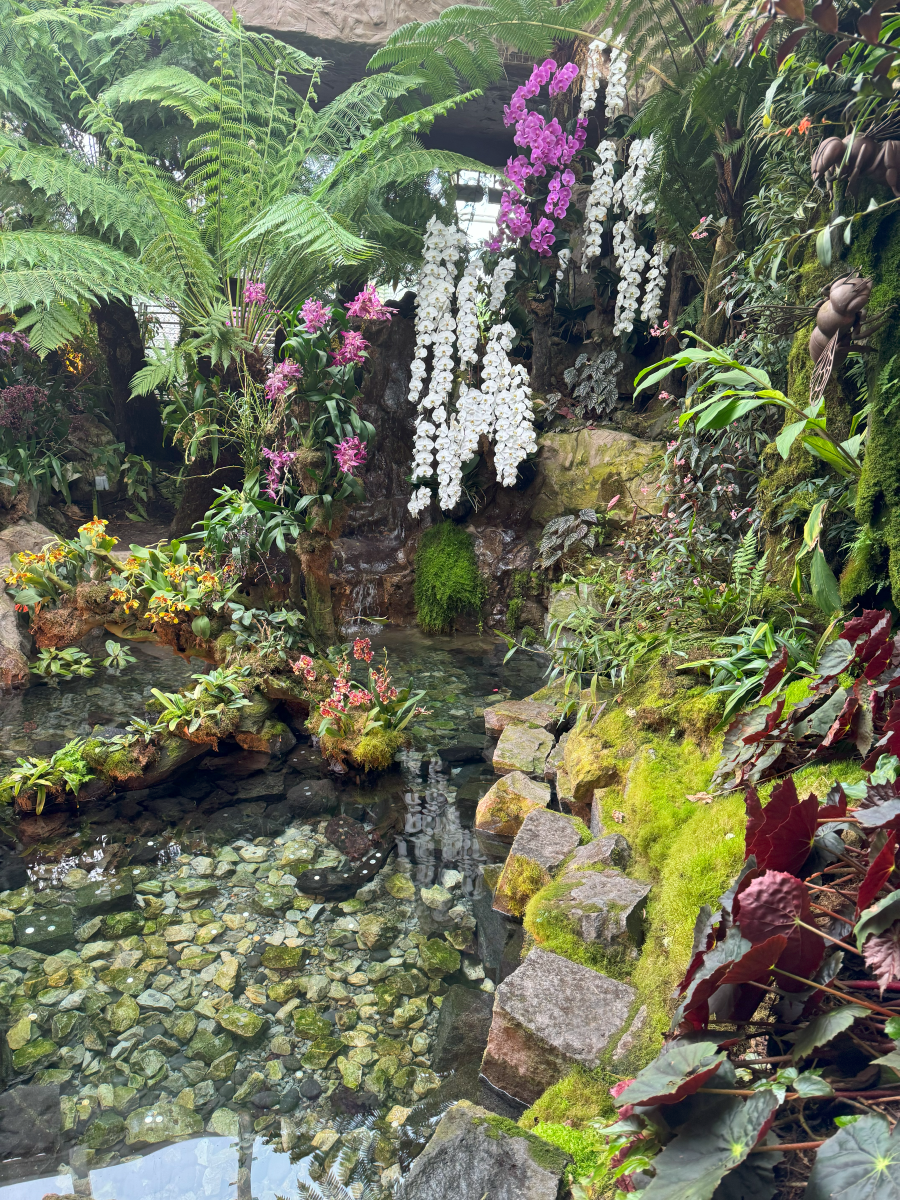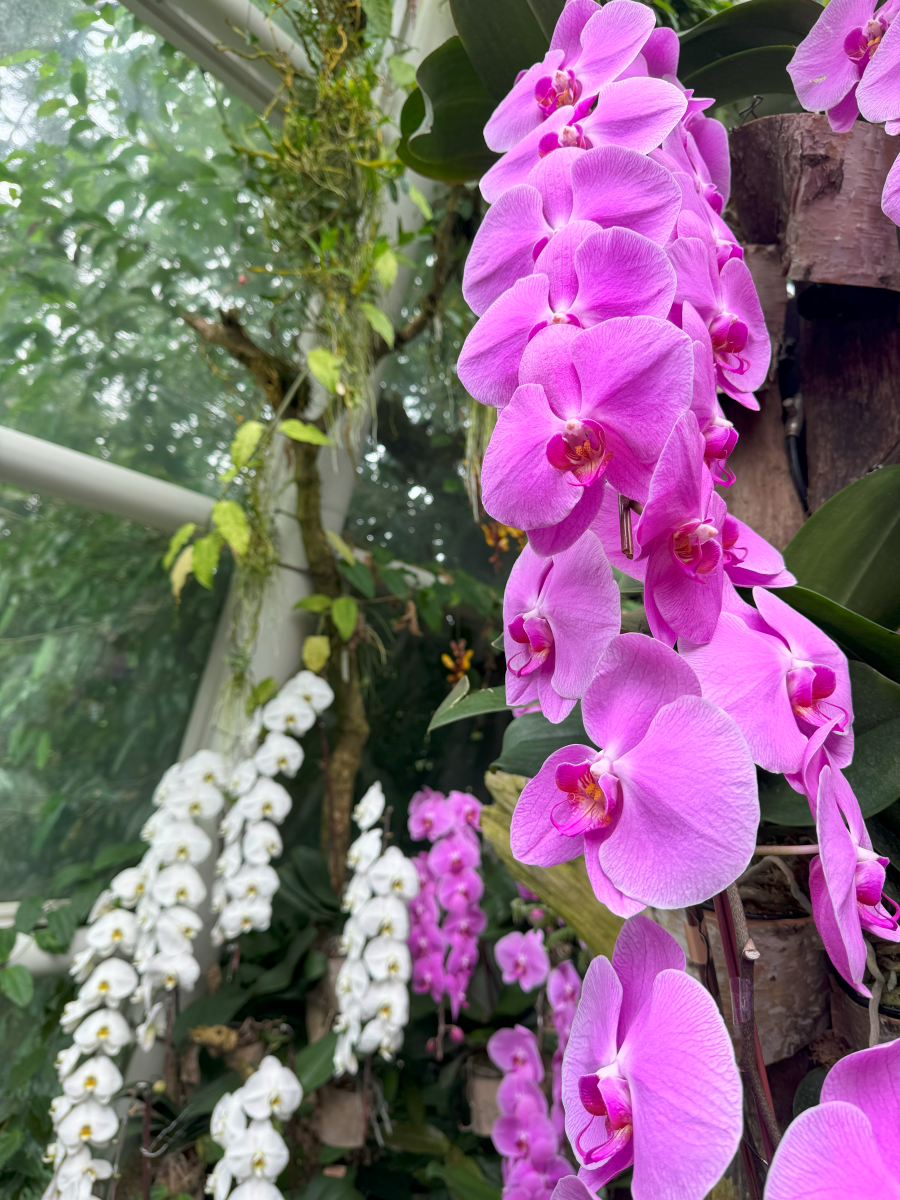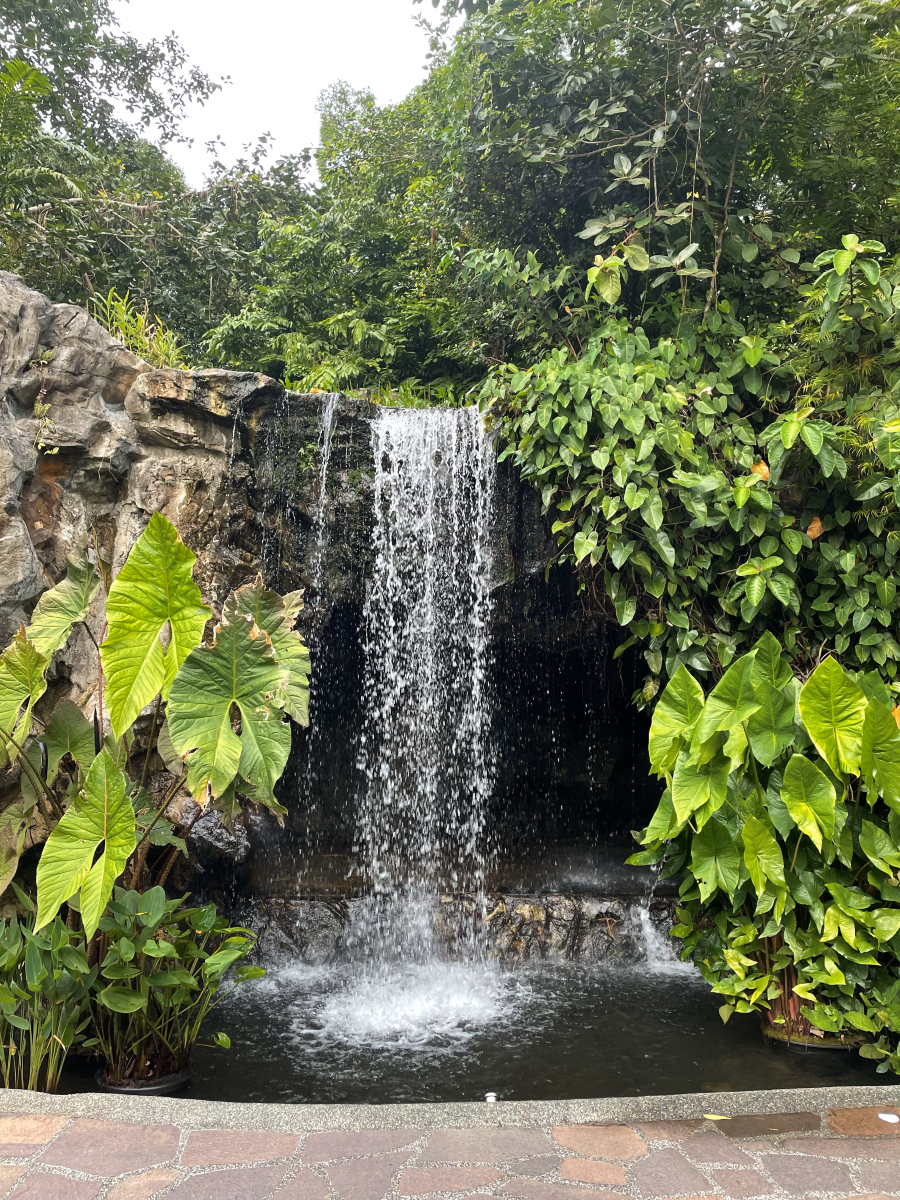
Singapore Botanic Gardens holds a special place in my heart. My earliest memory of my visit here was when I was all but 4. I vividly remember it being a nice cool day and the rain has just stopped. The pathways were wet and I was asked to pose and smile for the camera several times as we explored the garden. I love Botanic Gardens for its lush green landscape and the beautiful foliage of trees.
Today, Singapore Botanic Gardens is still the same but then again, different. It’s the same revered old trees but with the addition of new attractions and flora which made a difference in providing for a more immersive experience. Singapore Botanic Gardens is even more captivating and enjoyable to explore. The additional attraction which I particularly enjoy is the Rain Forest walking trail which offers a breathtaking view of the canopy of trees spanning across the vast expanse of its grounds.
So it was with good reason that my heart felt a little stirring when Singapore Botanic Gardens was inscribed as a UNESCO World Heritage Site!
Come and discover Singapore Botanic Gardens. Spread across 82 hectares, this UNESCO World Heritage Site offers a myriad of lush landscapes, diverse flora, and serene trails waiting to be explored. With so much to see and explore, it’s easy to feel overwhelmed so this walking trail is designed to ensure you make the most of your visit and uncover Singapore Botanic Gardens for unforgettable experience. So, come and immerse yourself in the tranquil ambiance of this botanical haven.
- This walking trail starts from Bukit Timah Gate. Take either the Circle (yellow) / Downtown (blue) line to get to Botanic Gardens MRT station.
- The walking route ends at Tanglin Gate where Napier MRT station is conveniently located and it’s only two stops away from Orchard MRT.
- Singapore Botanic Gardens is opened daily from 5am to 12 midnight
- While it is free to enter Botanic Gardens, the only place which requires a ticket is the National Orchid Garden.
- This walking route would take around 4 hours, so make sure to have sunscreen, comfortable shoes, umbrella and water.
1. Trellis Garden

Begin your journey at the Trellis Garden, where you’ll be greeted by the sight arched trellis adorned with vines or climbers. This is a showcase of climbers by Singapore Botanic Gardens and if you look closely, you’ll discover that there are many different types of interesting vines here and provides a cool shady respite from the sun. This picturesque garden is a hotspot for photo-taking, thanks to its charming foliage where it captures the enchanting interplay of light and shadow as it dances across the foliage.
2. Eco-Lake
Next, make your way to the serene Eco-Lake where you’ll find the graceful presence of Black Swan hailing from Western Australia. Nestled within the serene confines of this lake are vital ecosystems teeming with diverse plant and animal life. Explore the rich tapestry of flora within the Eco-Garden, where a symphony of bamboo groves, vibrant bougainvilleas, luscious fruit trees, and fragrant herbs and spices harmonize to create a botanical paradise.
3. Jacob Ballas Children’s Garden
Nestled within the lush expanse of the Singapore Botanic Gardens lies a hidden gem: Jacob Ballas Children’s Garden, the first garden in Asia exclusively dedicated to children.
A visit to Jacob Ballas is a must for families seeking adventure and fun. Beyond mere play, Jacob Ballas aims to nurture a deep appreciation for nature in children. Designed as a holistic learning environment, the garden provides ample opportunities for young minds to delve into plant ecology and environmental stewardship. Children can venture across the suspension bridge, traverse nature play areas, or meander along the serene stream. Treehouses beckon budding naturalists, offering a lofty vantage point to observe the surrounding flora and fauna. Whether scaling treehouses, observing plant growth, or simply basking in the beauty of nature, Jacob Ballas Children’s Garden is a haven where imagination flourishes and curiosity thrives.
4. Ethnobotany Garden
The Ethnobotany Garden showcases a rich tapestry of over 300 plant species which were deeply ingrained in the traditional cultures of the Malay Archipelago, Indochina, and South Asia. The outdoor garden is thoughtfully divided into four distinct zones and a dedicated Centre for Ethnobotany, each offering unique insights into the cultural significance and traditional uses of indigenous plants.
Living Zone: Here, a diverse array of wild fruits, vegetables, and ferns, traditionally foraged by indigenous tribes of Peninsula Malaysia and Borneo, flourish. As a special highlight, artificial hives housing stingless bees provide a captivating glimpse into the vital role of pollination, offering educational opportunities for visitors, especially school groups.
Craft and Construction Zone: Explore the profound connection between nature and craftsmanship as you encounter plants extensively utilized for traditional crafts and construction, all integral to indigenous communities’ artisanal endeavors. Additionally, discover various mangrove species essential for tanning processes.
Symbolism Zone: Delve into the symbolic significance of plants deeply intertwined with cultural ceremonies and beliefs. Stand in awe of the venerable Banyan tree, an emblem of strength and resilience, while exploring aromatic resin-producing plants that play pivotal roles in traditional rituals.
Medicinal Zone: Embark on a journey of healing and wellness amidst a myriad of plant species revered for their medicinal properties. Encounter familiar remedies like Tongkat Ali as well as lesser-known treasures like the White Bat Lily, cherished for its efficacy in treating various ailments, including skin rashes.
Centre for Ethnobotany: Uncover the intricate relationship between plants and humanity at the Centre for Ethnobotany, a hub of knowledge and exploration. Engage with interactive displays spanning two levels, illuminating how plants have shaped cultures and influenced global history. Please note that the Centre is closed on the last Wednesday of every month.
5. Foliage Garden
Dive into a world of botanical wonder as the Foliage Garden showcases an impressive array of ornamental plants boasting vibrant foliage in a myriad of shapes and textures. Here, visitors will discover that the allure and diversity of plants extend far beyond their blooms alone. Explore the intriguing realm of carnivorous plants, specially adapted to thrive in nutrient-poor environments by trapping and digesting insects. Keep an eye out for the striking ‘giant’ form of Raffles’ Pitcher Plant, distinguished by its crimson-hued cups and expansive funnel-shaped upper pitchers—a true highlight of the garden.
Adapted to their respective habitats, plants exhibit an array of leaf forms, from heart-shaped to palm-shaped, each serving a unique purpose. Leathery or thin leaves offer adaptive advantages in tropical climates, while hairy leaves serve as a natural defense mechanism against herbivores, adding an extra layer of intrigue to this botanical paradise.
Meticulous attention has been paid to the height, form, and arrangement of plants, to ensure a harmonious composition throughout the garden. To add on to the experience, the unique walkway in Foliage Garden offers a captivating perspective, allowing glimpses of plants flourishing beneath your feet—an experience distinct from the traditional boardwalk. For a better view of the entire landscape, head to the viewing deck and to take in the breathtaking surroundings.
6. Fragrant Garden
Experience the different scents that nature has to offer in the Fragrant Garden. You’ll discover a diverse array of plants that have evolved to produce captivating scents. Their blooms entice butterflies and other insects. Throughout history, fragrant species have been cherished across cultures for their sweet aromas, finding applications in rituals, religious ceremonies, traditional medicine, aromatherapy, and the thriving industry of perfumery, both traditional and modern. Come and indulge your senses here.
7. Evolution Garden
The Evolution Garden offers immersive trails tracing a timeline spanning 300 million years. Spanning 1.5 hectares, at the heart of the garden lies its ‘Jurassic Park’ centerpiece—magnificent Tree Ferns and Cycads—transporting visitors back to prehistoric times. Wander along these pathways and witness the fascinating process of natural evolution unfold before your eyes. Here, amidst lush greenery, the evolutionary saga of plant life on our planet comes to life from the emergence of primitive lichens to the evolution of ferns, and the transformation of petrified trees into modern-day plants. Marvel at the resilience and complexity of plant life and gain insights into the pivotal role that plants play in sustaining life on Earth, serving as oxygen producers, habitat providers, and essential components of the planet’s delicate ecosystems.
8. Symphony Lake

Known for its picturesque charm, Symphony Lake serves as the idyllic backdrop for the acclaimed Shaw Foundation Symphony Stage, where the Singapore Symphony Orchestra delights audiences with regular open-concept concerts, earning the lake its distinguished name. Nestled within the centre of the Singapore Botanic Gardens, Symphony Lake offers not only serene beauty but also serves as a cultural hub, hosting complimentary concerts for the public to enjoy amidst the lush greenery and serene waters of this iconic botanical haven.
9. National Orchid Garden

The National Orchid Garden is truly the highlight and pride of Singapore Botanic Gardens. Since its inception in 1859, the Singapore Botanic Gardens has fostered a deep connection with orchids. The culmination of its orchid breeding program, which commenced in 1928, demanded a dedicated space where the fruits of labor could be showcased in all their resplendent glory. Thus, the National Orchid Garden was born.

With a breathtaking display of over 1000 species and 2000 hybrids, the National Orchid Garden stands as a testament to the unparalleled beauty of these exquisite blooms. Among its notable features is the Tropical Montane Orchidetum, an immersive experience that simulates the lush surroundings of a tropical montane forest where an array of orchids and other botanical wonders, captivate visitors with their vibrant hues and delicate forms.


Pay homage to Singapore’s national flower at the Vanda ‘Miss Joaquim’ Garden and learn about the history and cultural significance of this beloved flower.
The National Orchid Garden is a paid attraction so be sure to book your tickets online.
10. Ginger Garden

Explore the world of gingers at the Ginger Garden, a captivating sanctuary showcasing several hundred species of gingers and plants from related families. Spanning one hectare, this botanical marvel invites visitors on.
With over 250 species, the Ginger Garden offers a diverse array of gingers in all their splendid variety. Delight in the sight of these botanical wonders, adorned with striking foliage and vibrant flowers, as you wander through curated zones that highlight gingers organized by their regions of origin. Step behind a cascading waterfall and immerse yourself in a sensory journey through lush greenery and the tranquil ambiance of a pool adorned with magnificent Amazon water lilies.
11. Learning Forest
Embark on an immersive journey through the treetops at the Learning Forest which showcases the rich ecosystems of Southeast Asia. Traverse elevated walkways, canopy bridges, and boardwalks as you encounter towering trees and rare wildlife.
The Learning Forest seamlessly merges with the existing 6-hectare Rain Forest, creating an expansive forest habitat for exploration and discovery. Venture into the Learning Forest and embark on a journey through diverse ecosystems, guided by a network of boardwalks and elevated walkways. Traverse habitats ranging from freshwater forest wetlands to lowland rainforests, encountering fascinating trees with distinctive forms and bark.
Experience the HPL Canopy Link, spanning 200 meters, the barrier-free pedestrian bridge of the HPL Canopy Link connects the Learning Forest to the Gallop Extension, offering panoramic views as it ascends into the canopy of a recreated lowland deciduous forest habitat. Immerse yourself in the Keppel Discovery Wetlands, where you can learn about freshwater forest ecosystems, or wander amidst towering tree species at the SPH Walk of Giants.
12. Sun Garden and the Bandstand Gazebo
The Sun Garden showcases a diverse collection of succulents and other plants indigenous to arid regions such as deserts. Against the backdrop of lush tropical foliage, the desert landscape provides a striking contrast, highlighting the unique beauty of these arid-adapted species.
Nearby is the iconic Bandstand, an octagonal gazebo erected in 1930 that has retained its original charm throughout the years. Situated atop a small hill that once stood as the highest point at the Tanglin Core site, the Bandstand served as a venue for bands to entertain way back in the 1860s. Today, the Bandstand remains a beloved spot for wedding photographs and stands as an enduring symbol of the Gardens. A distinctive feature of the Bandstand is the ring of Yellow Rain Trees encircling it. Originally sporting light green foliage, some of these trees have undergone a mutation resulting in vibrant yellow leaves.
13. Prisoner of War Brick Steps
Trace the footsteps of history at the Prisoner of War Brick Steps which reflect the sacrifices of prisoners of war during World War II. Etched into the bricks are tiny, uneven arrows, carved by those imprisoned in Changi Prison. Later, Australian prisoners of war, held captive by Japanese forces after the Gardens fell under their control in 1942, laid these bricks. The significance of these engravings remained largely unnoticed until 1995 when a group of Australian veterans, revisiting the Plant House, recognized the arrows as symbols of quiet resistance. However, today, it is a popular spot for young couples and newlyweds. Reflect on the past as you climb these historic steps, each one a testament to the resilience and courage of those who came before us.
14. Swan Lake Gazebo
The Swan Lake, a beloved attraction within the Singapore Botanic Gardens, holds a storied history dating back to its construction in 1866. It stands as the oldest ornamental water-feature in Singapore. The lake teems with a diverse array of aquatic plants and fish species. Its tranquil waters serve as a habitat for various aquatic life forms, contributing to the ecological richness of the Gardens. Adding to its allure is the picturesque island adorned with a cluster of Nibong palms, planted on the island in 1891. This iconic feature enhances the scenic beauty of the lake, creating a tranquil oasis within the bustling Gardens.
Beyond its aesthetic appeal, the Swan Lake plays a vital role as a water source, supplying much-needed water for the surrounding plant life within the Tanglin Core. Its significance as a natural resource underscores its importance as a cornerstone of the botanical heritage of Singapore.
Finally, conclude your journey at the Tanglin Gate.
If you’ve explore Singapore Botanic Gardens with this walking trail, I’d love to hear about your experience! Feel free to drop me a comment below or connect with me on Facebook, Instagram, and Pinterest. My handle across social media platforms is singaporenotboring. I welcome your feedback and it will greatly help me in refining and enhancing the walking routes and guides, ensuring they bring value to visitors wanting to discover and experience Singapore. Thank you!
